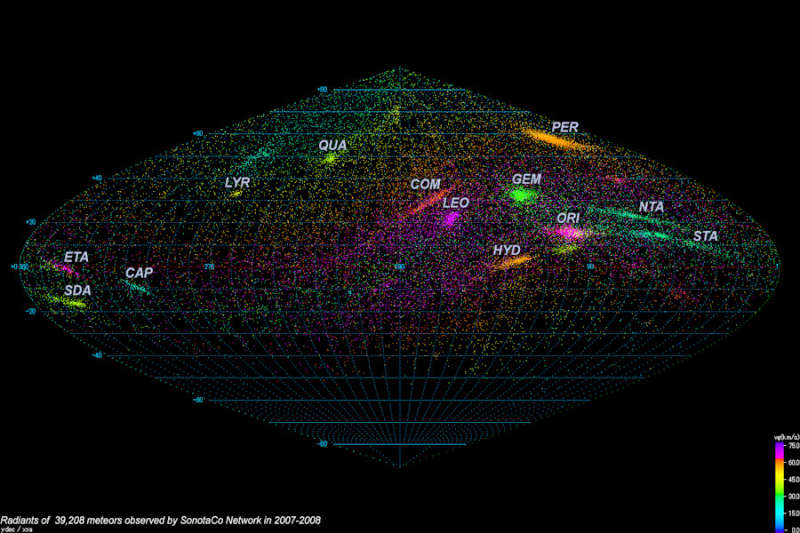Credit & Copyright: SonotaCo Network, Japan
Explanation:
Where do meteors come from?
Visible meteors are typically sand-sized
grains of ice and rock that once fragmented from comets.
Many a meteor shower has been associated with a
known comet, although some
intriguing
orphan showers do remain.
Recently, a group of
meteor enthusiasts created a network
of over 100 video cameras placed at 25 well-separated locations across
Japan.
This unprecedented network recorded not only 240,000 optically
bright meteors over two years,
but almost 40,000 meteors seen by more than one station.
These multiple-station events were particularly interesting because they enabled
the observers to extrapolate meteor trajectories back into the
Solar System.
The resulting radiant map is shown above, with many
well known meteor showers labelled by the first three letters of the
home constellation.
Besides known meteor showers,
eleven new showers were identified
by new radiants on the sky from which
meteors appear to flow.
The meteor sky is ever changing, and it may be possible
that new shower radiants will appear in the future.
Research like this could also potentially identify previously unknown comets or asteroids
that might one day pass close
to the Earth.
1999 2000 2001 2002 2003 2004 2005 2006 2007 2008 2009 2010 2011 2012 2013 2014 2015 2016 2017 2018 2019 2020 2021 2022 2023 2024 2025 |
Yanvar' Fevral' Mart Aprel' Mai Iyun' Iyul' Avgust Sentyabr' Oktyabr' Noyabr' Dekabr' |
NASA Web Site Statements, Warnings, and Disclaimers
NASA Official: Jay Norris. Specific rights apply.
A service of: LHEA at NASA / GSFC
& Michigan Tech. U.
|
Publikacii s klyuchevymi slovami:
meteor - meteor shower - radiant - Meteornyi potok - Meteor - komety - asteroidnaya opasnost'
Publikacii so slovami: meteor - meteor shower - radiant - Meteornyi potok - Meteor - komety - asteroidnaya opasnost' | |
Sm. takzhe:
Vse publikacii na tu zhe temu >> | |
